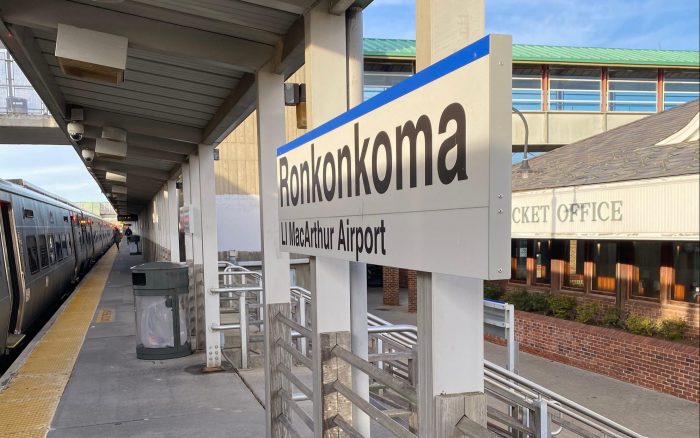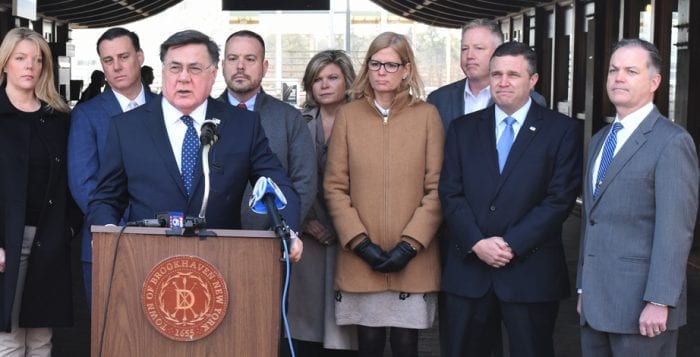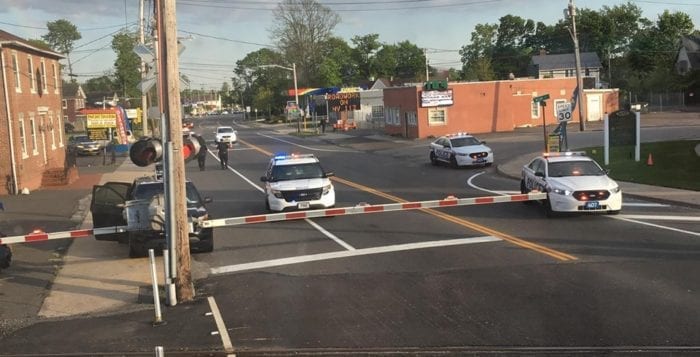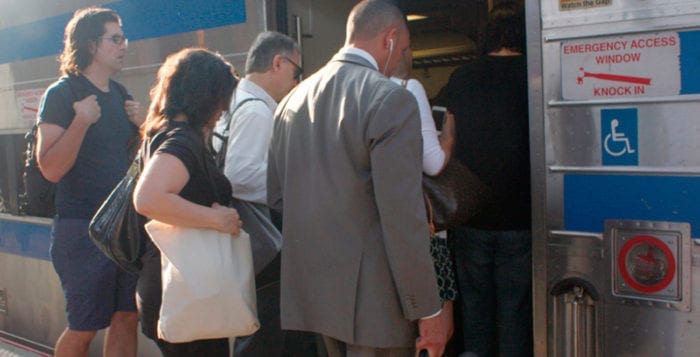New York State Assemblywoman Jodi Giglio (R-Riverhead) has openly criticized the state government for neglecting Long Island communities.
In an interview earlier this week, she addressed the upcoming gubernatorial primary election, her efforts to reach out to colleagues across the political aisle, the backward state of public infrastructure on the Island and more.
What is your professional background and how did you end up in the state Assembly?
I started my own construction company in 1997. I went to Stony Brook [University] at night while working full time during the day. I started to become very active in the construction industry and in land use — we owned 146 acres in East Quogue. My company is a certified Women Business Enterprise and I’m also a member of [the International Union of Operating Engineers] Local 138.
At the time, the Southampton Town Board put us in a moratorium for 2 1/2 years and raised our property taxes from $80,000 to $400,000. I was present at every hearing for the moratorium, where we couldn’t file an application and basically couldn’t do anything with our property. I felt that my property rights had been violated and became very involved in the political spectrum.
I started the Riverhead Business Alliance, where I had 50 businesses pay $300 a year so that I could hire somebody to send out emails letting businesses know about zoning changes that would be detrimental to their businesses. I set up a board of directors — and I was the president and the founder — and we just let everyone know what was happening in local government. A couple of years later, the business community asked me to run for the Town Board, which I did. I served on the Riverhead Town Board [as councilwoman] for 10 years.
There was a shift in government when [former state] Sen. [Kenneth] LaValle [R-Port Jefferson], who was a tremendous asset to the 1st Senate District, decided that he was no longer going to run. That’s when Anthony Palumbo [R-New Suffolk] decided to run for Senate. They asked me to run to fill his [state Assembly] seat, which I did, and I’m happy to serve the 2nd Assembly District in Albany.
You have spoken recently about the need to funnel tax dollars back into Long Island communities. In your opinion, are Long Islanders underserved by Albany?
Absolutely. I think all of Long Island is underserved by Albany. The largest concentration of New Yorkers is in New York City, so a lot of the money gets funneled into the five boroughs. I think that we pay a tremendous amount in tax dollars and a tremendous amount in our utility costs and that we are underserved.
However, I am very close to a lot of people on the other side of the aisle. I explain to them the problems that we have in our district and that we need help. I have been inviting them out here to come to different events, such as the Bell Town Heritage Area [in Aquebogue], where a friend of mine in the Assembly, Alicia Hyndman [D-Springfield Gardens], actually came out with her daughter and spent the day with me out here in the district, so that I could show her some of the challenges we face. On Saturday for Juneteenth, I went into Hempstead and spent the day with my dear friend, Taylor Darling [D-Hempstead] who is also in the majority, to see what her population is faced with.
I think that’s what it really takes: Not being a foreigner to other areas of the state, to realize what their needs are, and to make sure that we all work together to bring some of that money and some of those resources back to Long Island.
As local residents enter the voting booth for next week’s gubernatorial primary elections, what are some important issues that they should keep in mind?
The important issues are the high taxes that we pay in New York state and getting people back to work. I think that shutting down the economy and making people dependent on the government is problematic and it hasn’t worked in other countries.
I’ve worked with Congressman Lee Zeldin [R-NY1] since 2009 in his campaigns and have worked very closely with him over the years to make sure that our voices are heard here on Long Island. I think he’s been a pretty good advocate for us. I’ve listened to the debates and I think all of the candidates make great points. They have different areas of expertise that could help the state and I hope that whoever becomes the governor will tap into those assets, knowledge and experience that those others have.
I think that Lee Zeldin is the most experienced person running for governor in that he served in the state Senate and he also served in Congress, so he knows the mechanisms of government and can hit the ground running right away because we need a quick reversal of what is happening right now in the state.
Two Long Islanders will be on the primary ballots next week: Zeldin and Rep. Tom Suozzi (D-NY3). What does this say about the relationship between Long Island and Albany?
Long Islanders are mad. Whether it’s from the South Shore or the North Shore, the East End or the middle of Long Island, people here are mad. Our Long Island Expressway was a debacle for too many years. We needed that federal infrastructure money and I’m glad to say some of it is coming back to Long Island.
Long Island is a very unique place. There are a lot of people across the state that are spending a lot of time on Long Island, enjoying our waterfronts and our fisheries, our marinas and our farms, our commerce and our beaches. It’s important that we promote ourselves and make sure that Long Island has a strong voice in the state government.
In your opinion, is the MTA-LIRR underperforming? And what can be done to expedite services and make the railroad more responsive to Long Island communities?
I can tell you that the New York State government is a crutch for the MTA whenever the MTA fails or overspends or has issues. I think that the current governor [Kathy Hochul (D)] shutting down the government for so long, especially in New York City — and the city government that shut everything down from theaters to shopping to restaurants — it really showed New York City that Long Island can work from home and that we don’t need to go into the city.
I think that is going to cripple the MTA even more. The fact that the current governor held back and kept shutting everything down, sending the troopers and child protective services into restaurants on Long Island and throughout the state to make sure that everybody was shut down was a further step into government dependency. We were just writing unemployment checks and encouraging people to stay home and not go to work.
How can the state government be brought closer to the people of Long Island?
As I said previously, by bringing people out here. A lot of people on the other side of the aisle in the majority are planning on coming out and spending some time with me out on Long Island this summer, including Majority Leader Crystal Peoples-Stokes [D-Buffalo]. We’re going to visit the wineries and the farms, look at the beaches and spend some time together. She has assured me that she will be out here with me and I plan on taking a trip up to Buffalo to see what her hurdles and her struggles are.
I think that by bringing people out farther on Long Island and seeing what we have out here … especially our expressway. Long Island has been neglected for far too long and we need to make sure that our roads are safe, that our law enforcement is making sure that our communities are safe and that there’s always somebody at the other end of the phone to answer the call.
Our volunteer firefighters and our volunteer EMS workers, they are finding it very unaffordable to live here. We need to make sure that there are incentives for them to stay as another aspect of public safety. That is the fundamental reason why we have a government: public health, safety, welfare and prosperity.
Is there anything else you would like to say to our local readers?
I would like to say that elections have consequences. It’s very important that everyone pays attention to who is running for office. Look them up on the internet. We have easy access now to look at the platforms of the people running for office. Pay attention to who’s running and who best represents your ideals, your values and your concerns.




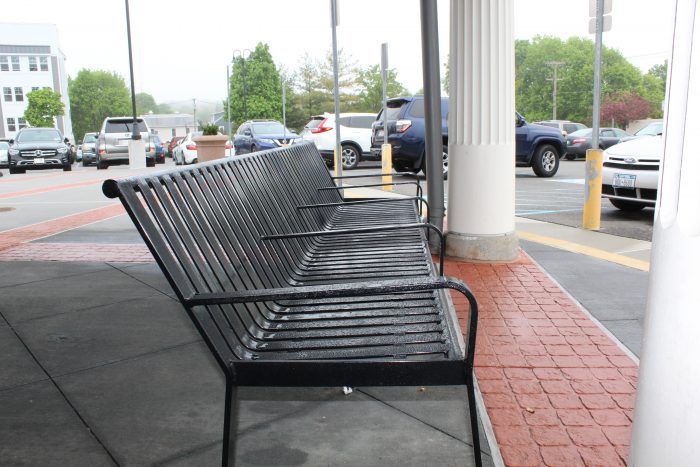
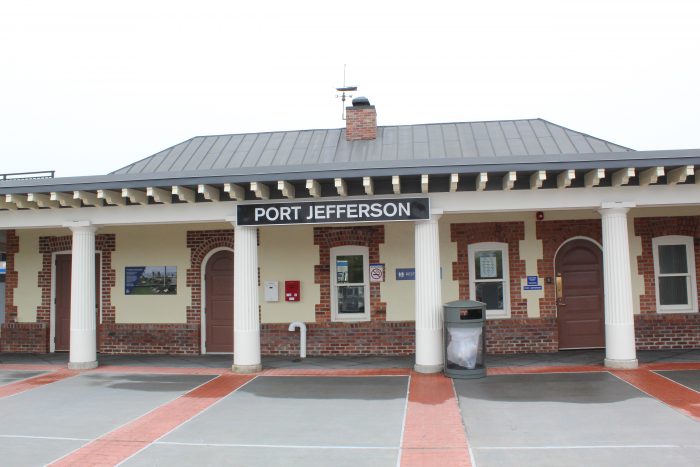

 The Station Street project has been in the works since 2016, when the village approved a master plan to revitalize Upper Port. As part of joint efforts between the village, the Town of Brookhaven, LIRR and the state Department of Transportation, the proposed Station Street would create a plaza that will help channel traffic from the main thoroughfare, alleviating congestion as drivers enter the village.
The Station Street project has been in the works since 2016, when the village approved a master plan to revitalize Upper Port. As part of joint efforts between the village, the Town of Brookhaven, LIRR and the state Department of Transportation, the proposed Station Street would create a plaza that will help channel traffic from the main thoroughfare, alleviating congestion as drivers enter the village.